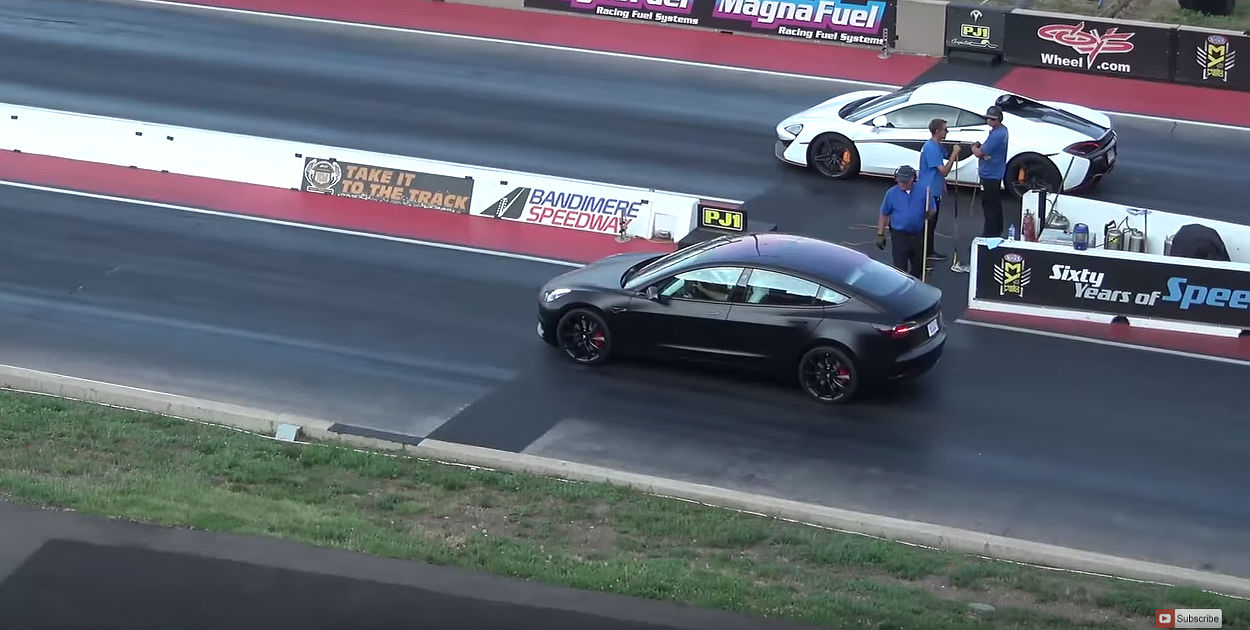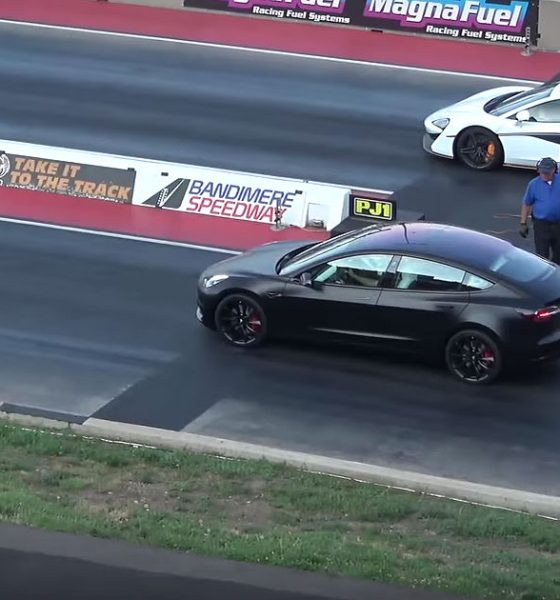

News
Tesla Model 3 Performance drag races McLaren 570S in impressive 1/4 mile showdown
There is no denying that the Model 3 Performance is quick, especially considering VBOX data validating the car’s 0-60 mph acceleration figures. But the question is, would it be fast enough to beat an actual supercar on the drag strip? Perhaps, even something as daunting as a McLaren 570S?
This was something explored recently by Tesla owner-enthusiast Erik Strait, better known as the host of YouTube’s DÆrik channel. Thanks to a friendly owner in the area, Erik has been able to test out the capabilities of the Model 3 Performance, which adds dual motors and a $5,000 Performance Upgrade package to the base trim, including 20″ Performance Wheels, Michelin Pilot Sport 4S summer tires, a carbon fiber rear spoiler, aluminum alloy pedals, and a top speed boost that enables the electric car to max out at 155 mph.
Tesla lists the Model 3 Performance with a 0-60 mph time of 3.5 seconds, which is plenty fast for a high-performance midsize sedan. Erik’s tests have shown that the Model 3 Performance is actually quicker than Tesla’s estimates, with the electric car hitting 60 mph in as low as 3.18 seconds when fully charged. Nevertheless, with a McLaren 570S as its opponent, the cards are stacked against the Model 3 Performance.
McLaren’s supercars are actually embedded in the history of Tesla, with CEO Elon Musk famously buying a McLaren F1 when he made his first millions after selling Zip2, his first company. Musk would later infamously wreck his McLaren F1 in a joyride with Peter Thiel, but the supercar would hold a special place in the Tesla CEO’s heart for years to come. When Musk unveiled the Model S P85D, for example, he made it a point to highlight that the electric car’s 0-60 mph time of 3.2 seconds is comparable to the acceleration of the supercar.
The 570S is McLaren’s “baby” supercar, slightly less powerful than its flagship vehicles like the 650S but incredibly fast just the same. The 570S is equipped with a twin-turbo 3.8-liter V8 engine making 562 hp and 443 lb-ft of torque. The car is also fitted with a slick-shifting 7-speed dual-clutch automatic transmission, which helps propel the vehicle from 0-60 mph in 3.0 seconds. The 570S’ top speed of 204 mph places it beside popular supercars like the Lamborghini Huracan 610-4 Spyder and the Ferrari 488 Spider 3.9 V8 Turbo. Compared to the McLaren 570S, the Model 3 Performance appears completely outclasses, with its dual motors producing a combined 450 hp and 471 lb-ft of torque and its top speed of 155 mph.
The Model 3 Performance dueled the McLaren 570S twice, and on both times, the electric car left the gas-powered supercar off the line. The Model 3 Performance did get the jump on the 570S to the quarter-mile mark, but stats-wise, Tesla’s electric car fell just around .2 seconds short of the supercar. The Model 3 Performance finished the quarter mile in 11.79 seconds at a speed of 115.18 mph in the first round, which was just slightly lower than the McLaren 570S’ 11.62 seconds and 124 mph. A second race rendered similar results, with the Model 3 Performance finishing the run in 11.79 seconds at 115.35 mph and the 570S completing the run in 11.58 seconds at 125.68 mph.
The Model 3 Performance is not a supercar, both in design and in function. While the McLaren 570S had bad launches on both races, the time differences between the two vehicles’ quarter-mile runs were just way too close. With stickier tires and a possible Ludicrous upgrade in the future, the Model 3 Performance could most certainly establish itself as a force to be reckoned with on the drag strip, just like its two larger siblings — the Model S P100D and the Model X P100D.
Watch the Model 3 Performance stand up to the McLaren 570S in the video below.

News
Tesla FSD fleet is nearing 7 billion total miles, including 2.5 billion city miles
As can be seen on Tesla’s official FSD webpage, vehicles equipped with the system have now navigated over 6.99 billion miles.

Tesla’s Full Self-Driving (Supervised) fleet is closing in on almost 7 billion total miles driven, as per data posted by the company on its official FSD webpage.
These figures hint at the massive scale of data fueling Tesla’s rapid FSD improvements, which have been quite notable as of late.
FSD mileage milestones
As can be seen on Tesla’s official FSD webpage, vehicles equipped with the system have now navigated over 6.99 billion miles. Tesla owner and avid FSD tester Whole Mars Catalog also shared a screenshot indicating that from the nearly 7 billion miles traveled by the FSD fleet, more than 2.5 billion miles were driven inside cities.
City miles are particularly valuable for complex urban scenarios like unprotected turns, pedestrian interactions, and traffic lights. This is also the difference-maker for FSD, as only complex solutions, such as Waymo’s self-driving taxis, operate similarly on inner-city streets. And even then, incidents such as the San Francisco blackouts have proven challenging for sensor-rich vehicles like Waymos.
Tesla’s data edge
Tesla has a number of advantages in the autonomous vehicle sector, one of which is the size of its fleet and the number of vehicles training FSD on real-world roads. Tesla’s nearly 7 billion FSD miles then allow the company to roll out updates that make its vehicles behave like they are being driven by experienced drivers, even if they are operating on their own.
So notable are Tesla’s improvements to FSD that NVIDIA Director of Robotics Jim Fan, after experiencing FSD v14, noted that the system is the first AI that passes what he described as a “Physical Turing Test.”
“Despite knowing exactly how robot learning works, I still find it magical watching the steering wheel turn by itself. First it feels surreal, next it becomes routine. Then, like the smartphone, taking it away actively hurts. This is how humanity gets rewired and glued to god-like technologies,” Fan wrote in a post on X.
News
Tesla starts showing how FSD will change lives in Europe
Local officials tested the system on narrow country roads and were impressed by FSD’s smooth, human-like driving, with some calling the service a game-changer for everyday life in areas that are far from urban centers.

Tesla has launched Europe’s first public shuttle service using Full Self-Driving (Supervised) in the rural Eifelkreis Bitburg-Prüm region of Germany, demonstrating how the technology can restore independence and mobility for people who struggle with limited transport options.
Local officials tested the system on narrow country roads and were impressed by FSD’s smooth, human-like driving, with some calling the service a game-changer for everyday life in areas that are far from urban centers.
Officials see real impact on rural residents
Arzfeld Mayor Johannes Kuhl and District Administrator Andreas Kruppert personally tested the Tesla shuttle service. This allowed them to see just how well FSD navigated winding lanes and rural roads confidently. Kruppert said, “Autonomous driving sounds like science fiction to many, but we simply see here that it works totally well in rural regions too.” Kuhl, for his part, also noted that FSD “feels like a very experienced driver.”
The pilot complements the area’s “Citizen Bus” program, which provides on-demand rides for elderly residents who can no longer drive themselves. Tesla Europe shared a video of a demonstration of the service, highlighting how FSD gives people their freedom back, even in places where public transport is not as prevalent.
What the Ministry for Economic Affairs and Transport says
Rhineland-Palatinate’s Minister Daniela Schmitt supported the project, praising the collaboration that made this “first of its kind in Europe” possible. As per the ministry, the rural rollout for the service shows FSD’s potential beyond major cities, and it delivers tangible benefits like grocery runs, doctor visits, and social connections for isolated residents.
“Reliable and flexible mobility is especially vital in rural areas. With the launch of a shuttle service using self-driving vehicles (FSD supervised) by Tesla in the Eifelkreis Bitburg-Prüm, an innovative pilot project is now getting underway that complements local community bus services. It is the first project of its kind in Europe.
“The result is a real gain for rural mobility: greater accessibility, more flexibility and tangible benefits for everyday life. A strong signal for innovation, cooperation and future-oriented mobility beyond urban centers,” the ministry wrote in a LinkedIn post.
News
Tesla China quietly posts Robotaxi-related job listing
Tesla China is currently seeking a Low Voltage Electrical Engineer to work on circuit board design for the company’s autonomous vehicles.

Tesla has posted a new job listing in Shanghai explicitly tied to its Robotaxi program, fueling speculation that the company is preparing to launch its dedicated autonomous ride-hailing service in China.
As noted in the listing, Tesla China is currently seeking a Low Voltage Electrical Engineer to work on circuit board design for the company’s autonomous vehicles.
Robotaxi-specific role
The listing, which was shared on social media platform X by industry watcher @tslaming, suggested that Tesla China is looking to fill the role urgently. The job listing itself specifically mentions that the person hired for the role will be working on the Low Voltage Hardware team, which would design the circuit boards that would serve as the nervous system of the Robotaxi.
Key tasks for the role, as indicated in the job listing, include collaboration with PCB layout, firmware, mechanical, program management, and validation teams, among other responsibilities. The role is based in Shanghai.
China Robotaxi launch
China represents a massive potential market for robotaxis, with its dense urban centers and supportive policies in select cities. Tesla has limited permission to roll out FSD in the country, though despite this, its vehicles have been hailed as among the best in the market when it comes to autonomous features. So far, at least, it appears that China supports Tesla’s FSD and Robotaxi rollout.
This was hinted at in November, when Tesla brought the Cybercab to the 8th China International Import Expo (CIIE) in Shanghai, marking the first time that the autonomous two-seater was brought to the Asia-Pacific region. The vehicle, despite not having a release date in China, received a significant amount of interest among the event’s attendees.








